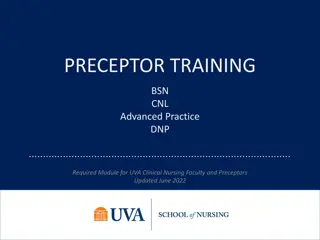Supervising groups: a focus on the practical.
Explore the practical aspects of supervising groups, focusing on group theory, development of supervision skills, and advantages of group format. Learn about setting up and maintaining a group, including tasks like contracting, addressing ethical concerns, and managing group dynamics. Gain insights into key skills for active leadership, clarity, preparation, and skilled use of frameworks for effective group supervision.
Download Presentation

Please find below an Image/Link to download the presentation.
The content on the website is provided AS IS for your information and personal use only. It may not be sold, licensed, or shared on other websites without obtaining consent from the author.If you encounter any issues during the download, it is possible that the publisher has removed the file from their server.
You are allowed to download the files provided on this website for personal or commercial use, subject to the condition that they are used lawfully. All files are the property of their respective owners.
The content on the website is provided AS IS for your information and personal use only. It may not be sold, licensed, or shared on other websites without obtaining consent from the author.
E N D
Presentation Transcript
Supervising groups: a focus on the practical Tracey Smith, Leeds Catharine Kay, Sheffield ISW March 2023
Aims of the session To think about the practice of supervising groups To learn about and reflect on group theory and process To begin to explore the development of your group supervision skills through the use of vignettes
Supervising groups: the practical Two broad areas that you will need to reflect on when setting up group supervision Creating the practical building blocks that help to support group learning Your theoretical emphasis CLARITY, PREPARATION & GOOD CONTRACTING UNDERPIN SUCCESSFUL GROUP WORKING (Adapted from Proctor and Inskipp in Scaife, 2009)
The advantages of group supervision There are many advantages in the group format, both in terms of learning from the work of others and because the authority of the supervisor is more likely to be challenged. Different previous trainings, cultural perspectives and life experiences among the supervisees enrich discussions and benefit all, including the supervisor. Ryle and Kerr (2002) Diversity of professional and cultural backgrounds, life stages and influencing personal history Supervisors task is to harness this diversity in the service of the supervisee and clients Many heads and hearts and better than one (Blunden and Beard, chapter on CAT group supervision 2017)
The hidden beginning What is the real contract of the group/work What is the organisational work - are people sent to you? What are the dynamics of the group? Do members like/have an interest in psychology etc.? What are the anxieties of the supervisees?
Setting up and maintaining a group Dynamic administration Practical tasks (room, time keeping) Contracting Addressing ethical concerns and boundaries Keeping group dynamics in mind Keeping stage of client work in mind Managing entries and exits
Setting up and maintaining a group - skills Active leadership Clarity - defining the task and how to do it Preparation - taking responsibility for what is negotiated and how Skilled use of frameworks e.g. functions of supervision, normative, formative and restorative (Inskipp and Proctor 1993)
Setting up and maintaining a group Managing changes in the group, beginning and endings Checking in Managing lateness and absences Managing tension between knowing and not knowing Managing when the group feels stuck Sharing the time Managing assessment tasks
What is a Group? Two or more human beings interacting with each other, who share same interests or have the same goals.
Group dynamics operate everywhere Initial bonding: how alike we are? Then how different we are; splits & attacks Idealisation/denigration of leaders Individual targeting (good or bad), scapegoating Group defences: pairing, flight/fight, up-down hierarchies, aggregation Anti-group phenomena: the group as a gang
Development of group dynamics The development of a group Dependency Challenging authority Defining individuality vs finding belonging Adult to adult (mutually nurturing, trust) Forming, storming, norming, performing (originally Tuckman 1965) Supervisors task is to get down from the pedestal and use their authority in service of the group
Similarities and differences in supervision groups Too much similarity = can feel stagnant, boring, overdependent Too much difference = risk of people feeling misunderstood, conflict, alienation Balance needed between the two We need to belong and feel understood but need to learn from others and be creative too
Group Dynamics: Does size matter? Small Medium Large Very Large
Small Group Therapy/Supervision Group 2-8: Participation relatively easy Family' dynamics can be observed Differences accentuated Can act as a container for the familiar, providing barrier against the outside world
Medium Group - Staff/Support Groups 9-20: Participation less easy than in small groups; formation of sub-groups. Sub-groups must form for the group to work. Individual differences are diluted and the links to the original family structures may get lost. Persecutory anxiety may arise.
Large Group - Workshops 20-70: Detachment may occur. Structure is necessary for the group to work. More difficult to keep a sense of belonging, contribute to the group, or find a suitable role. Loss of personal boundaries, emotions may be hard to manage and strong persecutory feelings may arise.
Very Large Group - Conferences More than 70 people: Internet based/online groups (e.g. social media), wider society Detachment & depersonalisation can occur. Even more difficult to keep a sense of belonging, contribute to the group or find a suitable role. Loss of personal boundaries, emotions may be hard to manage and strong persecutory feelings may arise.
Defence Mechanisms Repression Projection, Splitting & Projective Identification (Klein, 1946) Displacement Sublimation, Reaction Formation Denial Regression Rationalization, Intellectualization Identification with the Aggressor (Anna Freud, 1937) https://www.youtube.com/watch?v=BKDGFZ2urfk Ws&i** "My therapist says it's a defense mechanism,"
Bions Theory of Groups Groups are difficult, provoking feelings of conscious and unconscious anxiety in group members. Defensive Behaviour may be generated to deal with anxiety. Groups frequently exhibit a groupunconscious , manifesting itself in three different basicassumptions ( asif ), which is out of touch with reality. Groups may move from one basic assumption to another. But groups do not always become basic assumptions groups. If the group is in touch with reality, groups will get on with the task.
Two Groups: In every group two groups are present: 1. Primary Group (conscious) 2. Basic Assumption Group (ba/unconscious) When a group adopts any one of the basic assumptions, it interferes with the task the group is attempting to accomplish.
Basic Assumptions (BA): Dependency Members act as if they have no ideas/resources of their own may ask for guidance about how to do the task, denying own capabilities tend to lack initiative for action all power & authority invested in group leader; expectation that leader will provide nourishment & protection.
BA Fight-Flight Assumption is created that group is meeting to fight something or run away from it Members blame external factors (lack of resources, other teams, management) for all that feels uncomfortable Fight or flight seem only techniques of self preservation A leader is needed to direct the conflict.
BA Pairing Two members dominate & appear nurtured by group to increase cohesiveness Unrealistic hope something new will emerge & someone/ something will help them get on with tasks Many new ideas but nothing happens Hope something better comes up; if it did, would likely be rejected.
Basic Assumptions versus Work Group Groups may move from one basic assumption to another. But groups do not always become basic assumptions groups. If the group is in touch with reality, groups will get on with the task.
Vignette 1 You are supervising a group of trainee clinical psychologists in an NHS setting. You have noticed that when the supervisees present case material, they present it to you rather than to each other, and then look expectantly to you for a response. Interaction between participants is focussed very much on deciding whose turn it will be to present next.
What do you think is happening? What would you be thinking and/or feeling? What intervention(s) might you make?
Possible discussion points Bion s basic assumptions? Group in dependency mode. Might there be a level of distrust/envy/rivalry amongst supervisees that holds them back from engaging with each other s material? The supervisor could intervene by noting this is going on, and asking why people are working in this way, or could challenge the culture directly by inviting group members to comment on each other s work. There could also be parallel processes at work; the team might be working with highly dependent clients who look to their therapists for answers.
Types of Supervision Group (Proctor & Inskipp in Scaife, 2009): Authoritative group supervision or supervision in a group supervisor supervises individuals, members as more or less involved audience Participative group supervision or supervision with a group Supervisor supervises, members are taught and encouraged to participate actively Co-operative group supervision or supervision by the group Supervisor facilitates the group in sharing responsibility for the tasks of group supervision Peer group supervision peers take shared responsibility for supervision, members negotiate structure, leadership, roles & responsibilites
Vignette 2 You supervise a trainee who is running a group using CBT techniques to help people with anxiety related problems. Five out of the six members seem engaged, are always there on time, complete the exercises, and do their homework. The sixth person is often late, sometimes misses sessions altogether, and never does his homework. Other group members seem critical of him, but don't say anything.
What do you think is happening? What would you be thinking and/or feeling? What intervention(s) might you make?
Possible Discussion Points Bion: sixth member might be in flight mode, and this could be explored with him. But in a group, it is possible for one person to be on the receiving end of other's projections and behave accordingly - this man might be expressing resistance that others feel but don't express. A way forward might be wondering if other group members feel like not taking part, and then exploring ways this individual/others might deal with resistance.
Vignette 3 In a supervision group that you are running a supervisee begins a session she has experienced a family bereavement earlier in the week. The supervisee says that, although she has carried on working, her heart and mind have not been in the job. What do you do as supervisor?
What do you think is happening? What would you be thinking and/or feeling? What intervention(s) might you make?
Possible Discussion Points Boundaries - need to hold them but not be too rigid. Supervision is not therapy, but can and should be supportive. Depends on you as a supervisor how far you encourage exploration of this. Bear in mind that supervision is ultimately for client. The supervisor does have a "quality control" function and a responsibility to act if the service to client is not good enough. But then again wounded healers may make good healers...?























